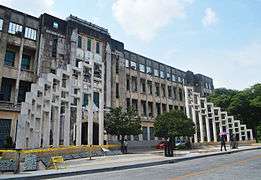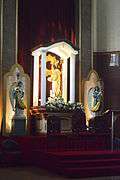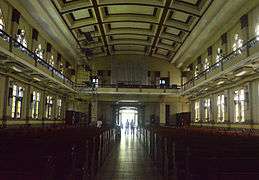University of Santo Tomas Central Seminary Building
| University of Santo Tomas Central Seminary Building | |
|---|---|
|
Central Seminary with the University field | |
| General information | |
| Type | Ecclesiastical and educational building |
| Architectural style | Art Deco |
| Location | España, Sampaloc, Manila |
| Coordinates | 14°36′37″N 120°59′21″E / 14.61028°N 120.98917°E |
| Completed | 1933 |
| Owner | University of Santo Tomas |
| Design and construction | |
| Architect | Fernando Ocampo |
| Awards and prizes | National Cultural Treasure |
The University of Santo Tomas Central Seminary Building currently houses the Santisimo Rosario Parish Church, the Central Seminary, and the Ecclesiastical Faculties of the Pontifical and Royal University of Santo Tomas in Manila. The Parish was canonically inaugurated on April 26, 1942 by Michael O'Doherty, the Archbishop of Manila during that time.[1] In January 25 2010, the National Museum of the Philippines formally declared the Central Seminary Building as a National Cultural Treasure.[2][3][4][5][6][7][8]
Architecture
The Central Seminary of the University of Santo Tomas was designed by Fernando Ocampo. It was built in the 1930s. The plan of the seminary was configured in the form of the letter E, with courtyards bisecting the wings. The boxy building had an elongated frontage assembling a continuous band of balconies and windows on the second and third level. The structure’s horizontally-oriented massing was broken by an engaged central section at the main entrance and two other similar treatments at the end portions. An art deco relief, bud-like finials, and a tableau embellished the stepped pylon at the entrance.[9]
Official Declaration
Section 3 of “The Cultural Properties Preservation and Protection Act” states that a “National Cultural Treasure is a unique object found locally, possessing outstanding historical, cultural, artistic and/or scientific value which is significant and important to this country and nation.” This prestigious recognition marks the first ever inclusion of an educational institution among the ranks of National Cultural Treasures, with the majority of structures being churches and the rest being terrestrial landmarks, intangible cultural property and movable objects.” As heritage sites, they will be accorded protection and recognition, giving importance to their witness of 400 years of tumultuous Philippine history.[2][4]
Gallery
- UST Central Seminary Building
 View from Gonzales Drive
View from Gonzales Drive Entrance and central facade
Entrance and central facade Regular fenestration
Regular fenestration Entrance to Santisimo Rosario Parish Church
Entrance to Santisimo Rosario Parish Church Columns
Columns
- Santisimo Rosario Parish Church
 View of the nave from the entrance
View of the nave from the entrance The coffered ceiling
The coffered ceiling Organ on the balcony
Organ on the balcony Balcony seats
Balcony seats Chancel
Chancel Window designs
Window designs Altar
Altar Viewed from the chancel
Viewed from the chancel
References
| Wikimedia Commons has media related to University of Santo Tomas Central Seminary Building. |
- ↑ Santissimo Rosario Parish of the University of Santo Tomas Santissimo Rosario Parish website accessed October 26, 2012
- 1 2 National Museum declares UST structures as National Cultural TreasuresUniversity of Santo Tomas website accessed October 27, 2012
- ↑ Formal Declaration of UST National Cultural TreasuresUniversity of Santo Tomas Museum of Arts and Sciences website accessed October 27, 2012
- 1 2 UST sites declared 'National Treasures'The Varsitarian website accessed October 27, 2012
- ↑ UST landmarks declared ‘National Treasures’The Inquirer website accessed October 27, 2012
- ↑ UST landmarks to be declared national cultural treasuresThe Manila Bulletin website accessed October 27, 2012
- ↑ UST spots declared cultural treasuresGMA Network website accessed October 27, 2012
- ↑ Untitled (Plaque inside building) (in English and Filipino). UST Main Building, near the front entrance of the UST Museum of Arts and Sciences: National Museum of the Philippines. 25 January 2010.
- ↑ Lico, Gerard (2008). Arkitekturang Filipino: A History of Architecture and Urbanism in the Philippines. Quezon City: The University of the Philippines Press. p. 339. ISBN 978-971-542-579-7.
